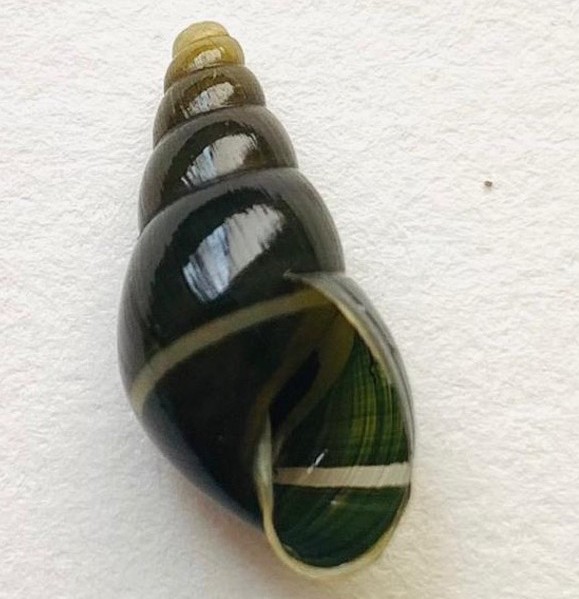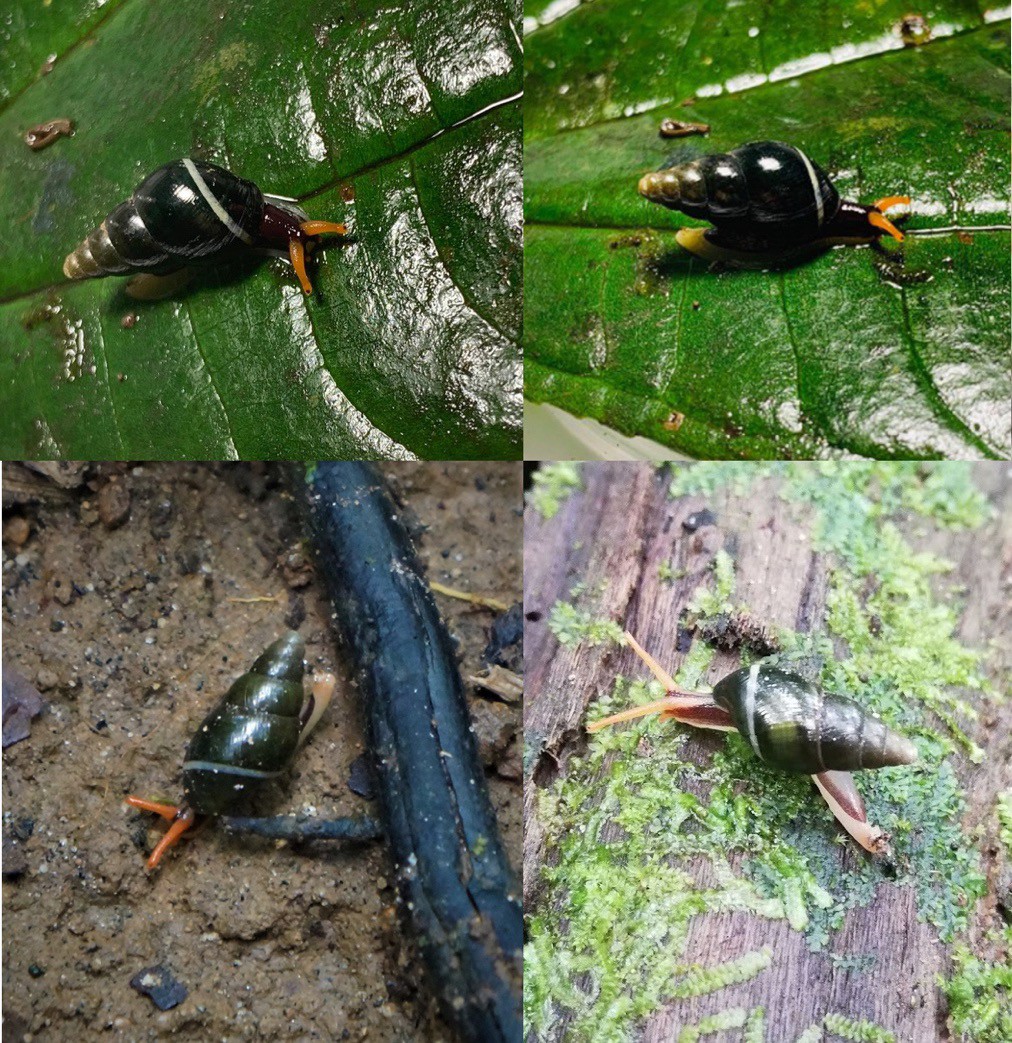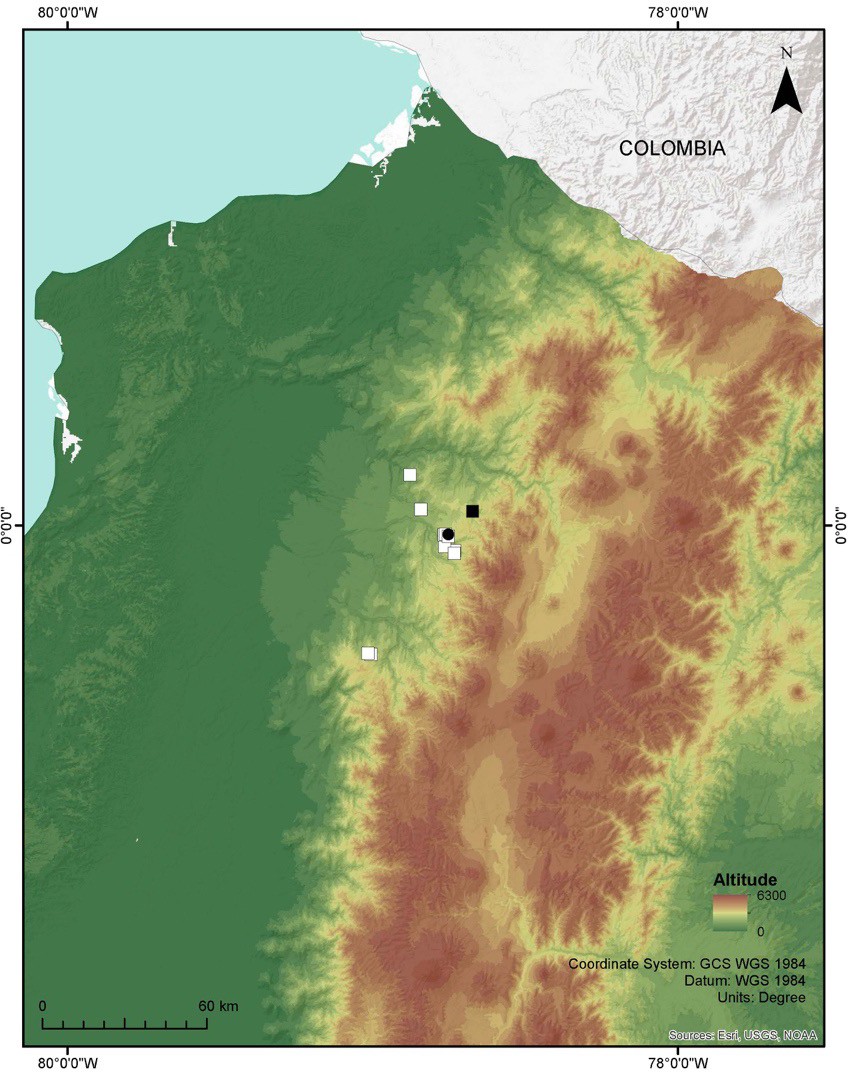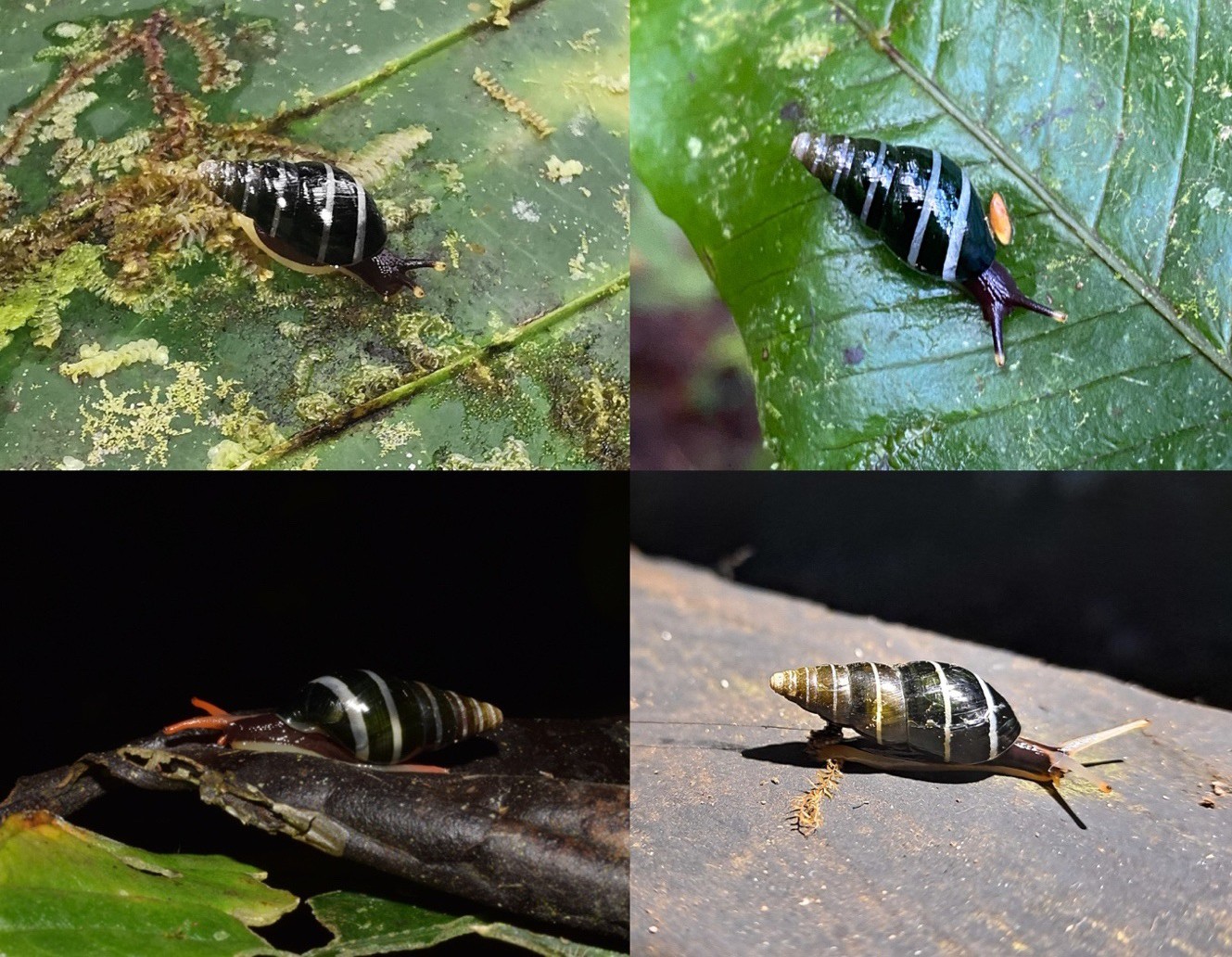



Sección B: Ciencias Biológicas y Ambientales
Comments on snails of the genus Zoniferella from Ecuador (Mollusca: Achatinidae)
Comentarios sobre caracoles del género Zoniferella de Ecuador (Mollusca: Achatinidae)
ACI Avances en Ciencias e Ingenierías
Universidad San Francisco de Quito, Ecuador
ISSN: 1390-5384
ISSN-e: 2528-7788
Periodicity: Bianual
vol. 15, no. 2, 2023
Received: 10 October 2023
Accepted: 14 November 2023
Corresponding author: diego.cisnerosheredia@gmail.com

Abstract: The genus Zoniferella includes six taxa of land snails from Colombia and Ecuador, about which little has been published beyond their original descriptions. In this paper, we present new records of Zoniferella vespera (Jousseaume, 1887), expanding its range across northwestern Ecuador. We provide the first description of the colouration in life for Zoniferella snails and we comment on the taxonomy of some species of Zoniferella, recognising the synonymy of Z. riveti (Germain, 1907) with Z. vespera but calling for further integrative analyses before recognising further synonyms between species of the genus.
Keywords: Andes, distribution, colouration, Synapterpes, taxonomy, Andes, distribución, coloración, Synapterpes, taxonomía.
Resumen: El género Zoniferella incluye seis taxones de caracoles terrestres de Colombia y Ecuador, sobre los cuales se ha publicado poco más allá de sus descripciones originales. En este trabajo, presentamos nuevos registros de Zoniferella vespera (Jousseaume, 1887), ampliando su área de distribución en el noroccidente de Ecuador. Proporcionamos la primera descripción de la coloración en vida para los caracoles Zoniferella y comentamos la taxonomía de algunas especies de Zoniferella, reconociendo la sinonimia de Z. riveti (Germain, 1907) con Z. vespera, pero llamando al desarrollo de más análisis integradores antes de reconocer otras sinonimias entre especies del género.
Zoniferella Pilsbry, 1906 was described as a subgenus of Synapterpes Pilsbry, 1896 and later recognised as a distinct genus [5,6]. Zoniferella are land snails characterised by a fragile, thin, glossy greenish-black shell, varying from yellowish olive green on the apex to dark greenish-black on most of the shell, having white stripes. Size, number of whorls, and stripes vary according to the species, and soft anatomy remains unknown [3]. Six taxa of Zoniferella have been described: Zoniferella albobalteata (Dunker, 1882) (type species by original designation), Z. vespera (Jousseaume, 1887), Z. riveti (Germain, 1907) and Z. riveti var. bizonalis (Germain, 1907), Z. bicingulata (Fulton, 1908), and Z. pilsbryi (Fulton, 1908), the latter being assigned to Zoniferella with uncertainty in its original description.
Hidalgo [29] suggested that Z. vespera and Z. riveti were junior synonyms of Z. albobalteata, a situation also suggested by Cisneros-Heredia and Valencia [9]. The latter authors also reported that Z. bicingulata could be a synonym of Z. riveti var. bizonalis. These synonymies were later officially proposed by Breure et al. [10], who only stated that “differences between Dunker’s species and the two taxa of Jousseaume and Germain are so slight, that we fail to see why they should be kept separate” and did not present any justification for the synonymy of Z. riveti var. bizonalis with Z. bicingulata.
Herein, we present new distributional records of Zoniferella in Ecuador, expanding its range across northwestern Ecuador, providing the first descriptions of its morphological and colouration variation, and commenting on the taxonomy of the genus.


Two individuals of Zoniferella were found at the Otonga Reserve (0°26’24” S, 78°43’19” W; 1815 m), county of Sigchos, province of Cotopaxi, Republic of Ecuador, on top of leaves of Melastomataceae and Araceae, in a very narrow, steep, and rocky ravine covered by old-growth dense forest, near the main station house, on 28 May 2021 by Roberto Valencia (Fig. 1–2). The snails were photographed alive. One specimen was deposited at the Museo de Zoología, Universidad San Francisco de Quito, Ecuador (ZSFQ) (Fig. 1). Photographs of one of these snails were posted in iNaturalist [11] (Fig. 2), where initial generic identification was provided. We confirmed the generic identification and restricted the species to Z. vespera, based on information provided by Pilsbry, Jousseaume and Cousin [1,3,12] and examination of photographs of the holotype [13]. Snails were identified as Zoniferella vespera due to the presence of the following diagnostic characteristics: shell ovate-acuminate, thin, delicate, very glossy, decorated with very thin irregular ridges; 6 whorls; spire long, conic; apex obtuse; aperture oval; peristome simple, acute; columellar margin straight; shell colouration dark green, getting paler towards the apex, with a circular white conspicuous band on the last whorl and columellar margin whitish [1,3,12]. The new specimen is slightly more globular and smaller than the holotype, but we consider that these differences are due to intraspecific variation (Fig. 2). Observations of snails matching this diagnosis of Z. vespera have been reported in iNaturalist from several localities in northwestern Ecuador: valley of Mindo and surrounding mountains, Pachijal, Mashpi, province of Pichincha; and San Francisco de las Pampas, province of Cotopaxi (Fig. 2–3, Table 1).

| Species | Collector | Year of observation | Year of publication | Locality | Province | Country | Latitude | Longitude | Uncertainty in km | Elevation in m | URL |
| Zoniferella vespera | Patiño | 2018 | 2018 | Mindo, valley of | Pichincha | Ecuador | -0.082382 | -78.732394 | 0.357 | 1700 | https://www.inaturalist.org/observations/17046546 |
| Zoniferella vespera | Schön, ML | 2017 | 2022 | Mindo, valley of | Pichincha | Ecuador | -0.068408 | -78.765328 | 2.73 | 1300 | https://www.inaturalist.org/observations/104455797 |
| Zoniferella vespera | jOrdis | 2020 | 2020 | Pachijal, Un Poco de Chocó | Pichincha | Ecuador | 0.052973 | -78.84228 | 0.004 | 1170 | https://www.inaturalist.org/observations/66893276 |
| Zoniferella vespera | Cianferoni, F. | 2009 | 2020 | San Francisco de las Pampas | Cotopaxi | Ecuador | -0.41994 | -79.00623 | 1.5 | 2000 | https://www.inaturalist.org/observations/62317763 |
| Zoniferella vespera | Gelis, R | 2018 | 2018 | Mindo, valley of | Pichincha | Ecuador | -0.090101 | -78.732673 | 0.244 | 1700 | https://www.inaturalist.org/observations/17060451 |
| Zoniferella vespera | aguilargm | 2019 | 2020 | Séptimo Paraiso | Pichincha | Ecuador | -0.030523 | -78.766507 | 0.647 | 1600 | https://www.inaturalist.org/observations/45556832 |
| Zoniferella vespera | Vizcarra S | 2014 | 2020 | Mashpi Lodge | Pichincha | Ecuador | 0.165901 | -78.877605 | 0.212 | 900 | https://www.inaturalist.org/observations/40932386 |
| Zoniferella vespera | scibugs | 2020 | 2020 | Séptimo Paraiso | Pichincha | Ecuador | -0.028831 | -78.762188 | 0.263 | 1600 | https://www.inaturalist.org/observations/37584288 |
| Zoniferella vespera | Grijalva, S | 2019 | 2019 | Estación Mindo USFQ | Pichincha | Ecuador | -0.035311 | -78.752791 | 0.05 | 1600 | https://www.inaturalist.org/observations/21849408 |
| Zoniferella vespera | wouter-oe | 2019 | 2019 | Pachijal, Un Poco de Chocó | Pichincha | Ecuador | 0.052339 | -78.843231 | ? | 1100 | https://www.inaturalist.org/observations/20837253 |
| Zoniferella vespera | Valencia, R | 2021 | 2021 | Reserva Otonga | Cotopaxi | Ecuador | -0.41667 | -79.01667 | 1.65 | 1900 | https://www.inaturalist.org/observations/84233579 |
| Zoniferella vespera | Falero, D | 2019 | 2019 | Mindo, valley of | Pichincha | Ecuador | -0.08223 | -78.733098 | 0.019 | 1700 | https://www.inaturalist.org/observations/32975401 |
| Zoniferella vespera | Gelis, R | 2020 | 2020 | Mindo, valley of | Pichincha | Ecuador | -0.078526 | -78.731235 | 0.404 | 1600 | https://www.inaturalist.org/observations/47932409 |
| Zoniferella vespera | Ramon, G | 2021 | 2021 | Mindo, valley of | Pichincha | Ecuador | -0.048717 | -78.775198 | 2.17 | 1300 | https://www.inaturalist.org/observations/82077716 |
| Zoniferella vespera | Cousin | 1887 | Los Puentes, type locality of Zoniferella vespera | Pichincha | Ecuador | 0.045833 | -78.674167 | 2 | 1500 | ||
| Zoniferella riveti | Rivet | 1907 | San Tadeo, type locality of Zoniferella riveti | Pichincha | Ecuador | -0.0291 | -78.7526 | 2 | 1700 |
Colouration in life of Z. vespera has not been described. Individuals of Z. vespera from the Otonga Reserve had the sole and border of foot yellowish cream, dorsal surfaces of the foot and head dark purplish, and tentacles bright orange (Fig. 2). This colouration in life is observed in other individuals reported in iNaturalist, with some intraspecific variation observed by some individuals having a whitish or orange band running towards the back from the base to each tentacle, and the tentacles coloured yellowish cream as the border of foot (Fig. 2). The colouration in life of the shell is like the coloration in preservation, but some individuals may look almost black.
Zoniferella vespera, Z. albobalteata, and Z. riveti are very similar, as indicated by Hidalgo [29] and Breure et al. [10]. Subtle differences in length (13–21 mm), number of whorls [6–7], and columella shape (straight or twisted) have been used to separate them. Zoniferella albobalteata was diagnosed from Z. vespera by its smaller length (13 mm vs. 17 mm in the holotype of Z. vespera) and a subreflexed columella (straight in Z. vespera) [3,7]. Zoniferella riveti was diagnosed from Z. vespera by having 7 whorls, a larger size (21 mm), a more slender shape, and a twisted columella [2,14]. The specimens of Zoniferella from Otonga are intermediate in size between Z. albobalteata and Z. vespera but smaller than Z. riveti and have a straight columella like the one reported for Z. vespera. These differences would seem to correspond to intraspecific variation of a single species, suggesting the possibility that Z. vespera and Z. riveti are junior synonyms of Z. albobalteata. However, Z. albobalteata is currently known only from its type locality in “sylvis humosis prope Pasto Columbiae” (= humid forests near Pasto, Colombia) [3,7], about 180 km N from the known range of Z. vespera. The type locality of Z. albobalteata is separated from the known range of Z. vespera by large rivers that are major biogeographic barriers (Patia-Guaitará, San Juan-Mira- Mataje, Santiago, Esmeraldas-Guayllabamba) and are in different biogeographic regions [15,16]. Complex diversification processes resulting in cryptic speciation have been reported in the geologically and biogeographically heterogeneous regions of northwestern Ecuador and southwestern Colombia [17–25]. Thus, at the moment, we do not follow Breure et al. [10] proposal to recognise Z. vespera as a synonym of Z. albobalteata and call for integrative taxonomic analyses that include topotypic material of Z. albobalteata. On the other hand, we agree with the synonymy of Z. riveti with Z. vespera due to their similar morphology and colouration and that the type locality of Z. riveti (“Cerro de San Tadeo, chemin de Pachajal [sic]” = San Tadeo, road to Pachijal) is about 10 km W from the type locality of Z. vespera and within its distribution range.
Zoniferella vespera (Jousseaume, 1887)
Mesembrinus vesperus Jousseaume, 1887: 168, pl. 3, fig. 2.
Mesembrinus vesperus—[12]: 234; [26]: 57.
Bulimulus visendus—[27]: 47–49; [28]: 247–248
Bulimulus visendus var. vesperus—[29]: 131
Synapterpes .Zoniferella. vesperus—[3]: 234, pl. 37, fig. 91
Synapterpes vesperus—[2]: 61; [14]: C48.
Synapterpes (Zoniferella) riveti Germain, 1907: 60. [10]
Zoniferella vespera—[6]: AphiaID 995660
The other three species of Zoniferella are easily differentiated from Z. vespera due to their colouration. Zoniferella riveti var. bizonalis and Z. bicingulata differ from Z. vespera by having two white bands on the last whorl, one of which further continues along the other whorls (one band in Z. vespera, restricted to the last whorl) [2,8,14]. Zoniferella pilsbry is separated from Z. vespera by having the lower whorls with narrow green spiral bands alternating with narrow white bands, eight whorls, and longer length (26 mm) [3]. Zoniferella riveti var. bizonalis and .. bicingulata were not compared in their original descriptions because they were published a year apart [2,8]. Based on the data provided in their descriptions and photographs of the holotypes [30,31], they would differ in the number of whorls (6½–7½) and the shape of the second white band (narrower than the first band in Z. r. bizonalis and the same size in Z. bicingulata). Unfortunately, the type locality of Z. bicingulata was not specified, cited only as Ecuador [8]. We suggest that their synonymy (as Z. bizonalis), as proposed by Breure et al.[10], also requires an integrative taxonomic approach to evaluate if their differences are only due to colour variation.
Photographs reported in iNaturalist of individuals with two bands on the last whorl (Z. riveti var. bizonalis . Z. bicingulata) usually differ by having the tentacles completely dark like the dorsal surfaces of foot and head, except for the eyes that are cream (Fig. 4). However, one individual showing two bands has the same colouration described for Z. vespera [32]. Another has tentacles completely cream-coloured and a whitish band running towards the back from the base to each tentacle [33] (Fig. 4).

Extensive habitat changes and loss across Ecuador have most probably threatened and pushed several snail species towards extinction. Montane cloud forests on the northwestern Andean slopes of Ecuador, the habitat of Zoniferella vespera, have been deeply affected by deforestation for timber extraction, agricultural expansion, and mining projects, with few old-growth forest fragments remaining in the region. Information on the diversity, ecology, and biogeography of terrestrial snails of Ecuador is deficient. Aside from works by Abraham Breure, Francisco Borrero, Modesto Correoso, and collaborators [10,34–39], little has been published on the fauna of terrestrial snails from Ecuador recently.
Acknowledgments
We thank Sergio Norona, guide at Otonga Reserve, and Roberto León and Samuel Cortese for their help in the field; Giovani Ramón and Emilia Peñaherrera-Romero of the Museo de Zoología of Universidad San Francisco de Quito for their support during lab work; Emilia Peñaherrera-Romero for helping with the map; Matt Parr for suggesting the generic identification in iNaturalist; Abraham S. H. Breure for reading an initial version of this manuscript, and two reviewers for their comments on the manuscript. We are grateful to the Otonga Reserve for allowing us to venture into the cloud forest that they have protected for decades; to the Natural History Museum London and the Muséum national d’Histoire naturelle for offering online photographs of type specimens; and to the Biodiversity Heritage Library BHL, Google Books, Archive.org, and the World Spider Catalog for making important literature freely available. Specimens were donated to the Museo de Zoología (ZSFQ), Universidad San Francisco de Quito, under patent 010-UBVS- OTQ-DZ2E-MAAE-2021, issued by the Ministry of Environment, Water and Ecological Transition of Ecuador. This work was supported by Universidad San Francisco de Quito USFQ and its College of Biological and Environmental Sciences through research and outreach funds assigned to Diego F. Cisneros-Heredia and operative funds assigned to the Institute of Tropical Biodiversity IBIOTROP-USFQ.
REFERENCES
[1] Jousseaume, F. (1887). Mollusques nouveaux de la République de l’Équateur. Bull Société Zool Fr., 12, 165–86.
[2] Germain, L. (1907). Sur quelques mollusques de la République de l’Équateur (Mission de M. le Dr. Rivet). Bull Muséum Natl Hist Nat. 1907(1), 52–68.
[3] Pilsbry, H. A. (1906). Manual of conchology structural and systematic, Vol. XVIII. Conchological Department, Academy of Natural Sciences of Philadelphia.
[4] Pilsbry, H. A. (1896). Note on Bulimus hanleyi and B. coronatus. The Nautilus, X(4), 46.
[5] Bank, R. A. (2017). MolluscaBase: Classification of the recent terrestrial Gastropoda of the World [Internet]. World Register of Marine Species WoRMS. https://www.marinespecies.org/aphia.php?p=sourcedetails&id=278821
[6] MolluscaBase. (2022). MolluscaBase: Zoniferella Pilsbry, 1906. World Register of Marine Species WoRMS. https://www. marinespecies.org/aphia.php?p=taxdetails&id=995660
[7] Dunker, G. (1882). Molluscis nonnullis terrestribus Americae australis. Jahrb Dtsch Malakozool Ges, (9), 377–80.
[8] Fulton, H. C. (1908). Descriptions of two new species of Synapterpes. J Molluscan Stud., 8(2), 84–5. doi: https://doi. org/10.1093/oxfordjournals.mollus.a066234
[9] Cisneros-Heredia, D. F. and Valencia, R. F. (2022). Comments on snails of the genus Zoniferella from Ecuador (Mollusca: Achatinidae), with restriction of the type locality “Los Puentes” for several species of Gastropoda and Arachnida. Biorxyv. doi: https://doi.org/10.1101/2022.03.03.482746
[10] Breure, A. S. H., Roosen M. T., Ablett J. D. (2022). Land and freshwater molluscs of mainland Ecuador: an illustrated checklist. Iberus, 40(1), 1–290. doi: https://doi.org/10.5281/zenodo.6519856
[11] Valencia R. F. (2021). Zoniferella vesperus. iNaturalist. https://www.inaturalist.org/observations/84233579
[12] Cousin, A. (1887). Faune malacologique de la République de l’Équateur. Bull Société Zool Fr., (12):187–287.
[13] MNHN. (1887). Collection: Molluscs (IM) Specimen MNHN-IM-2000-28158 - Holotype Mesembrinus vesperus Jousseaume. Muséum national d’Histoire naturelle. http://coldb.mnhn.fr/catalognumber/mnhn/im/2000-28158
[14] Germain, L. (1911). Étude sur les mollusques terrestres et fluviatiles recueillis par M. le Dr. Rivet. In Mission du Service Géographique de l’Armée pour la mesure d’un Arc de Méridien Équatorial en Amerique du Sud sous le contróle scientifique de l’Academie des Sciences 1899–1906. (C1–77). Gauthier-Villars, Imprimeur-Libraire du Bureau des Longitudes, de l’Ecole Polytechnique,.
[15] Terán, F. (1984). Geografía del Ecuador. Quito: Libresa, 462 p.
[16] Morrone, J. J. (2014). Biogeographical regionalisation of the Neotropical region. Zootaxa, 25, 3782: 1–110. doi: https://doi.org/10.11646/zootaxa.3782.1.1
[17] Cisneros-Heredia, D. F. (2006). Distribution and ecology of the western ecuador frog Leptodactylus labrosus (Amphibia: anura: leptodactylidae). Zool Res., 27(3), 225–34.
[18] Yánez-Muñoz, M. H., Meza-Ramos P. A., Cisneros-Heredia, D. F. and Reyes-Puig, J. P. (2010). Descripción de tres nuevas especies de ranas del género Pristimantis (Anura: Terrarana: Strabomantidae) de los bosques nublados del Distrito Metropolitano de Quito, Ecuador. ACI Avances en Ciencias e Ingenierías, 2(3). doi: https://doi.org/10.18272/aci.v2i3.40
[19] Yánez-Muñoz, M. H., Reyes-Puig J. P., Batallas-Revelo, D., Broaddus, C., Urgilés-Merchán, M., Cisneros-Heredia, D. F., et al. (2021). A new Andean treefrog (Amphibia: Hyloscirtus bogotensis group) from Ecuador: an example of community involvement for conservation. PeerJ., 9, e11914. doi: https://doi.org/10.7717/peerj.11914
[20] d’Horta, F. M., Cuervo, A. M., Ribas, C. C., Brumfield, R. T. and Miyaki, C. Y. (2013). Phylogeny and comparative phylogeography of Sclerurus (Aves: Furnariidae) reveal constant and cryptic diversification in an old radiation of rain forest understorey specialists: Sclerurusphylogeny and phylogeography. J Biogeogr., 40(1), 37–49. doi: https://doi. org/10.1111/j.1365-2699.2012.02760.x
[21] Pérez Álvaro, J., Arroyo, F., Neill, D. A. andVázquez-García, J. A. (2016). Magnolia chiguila and M. mashpi (Magnoliaceae): two new species and a new subsection (Chocotalauma, sect. Talauma) from the Chocó biogeographic region of Colombia and Ecuador. Phytotaxa, 286(4), 267. doi: https://doi.org/10.11646/phytotaxa.286.4.5
[22] Arteaga, A., Salazar-Valenzuela, D., Mebert, K., Peñafiel, N., Aguiar, G., Sánchez-Nivicela, J. C. et al. (2018). Systematics of South American snail-eating snakes (Serpentes, Dipsadini), with the description of five new species from Ecuador and Peru. ZooKeys, 766, 79–147. doi: https://doi.org/10.3897/zookeys.766.24523
[23] Guayasamin, J. M., Cisneros-Heredia, D.F., Vieira, J., Kohn, S., Gavilanes, G., Lynch, R. L. et al. (2019). A new glassfrog (Centrolenidae) from the Chocó-Andean Río Manduriacu Reserve, Ecuador, endangered by mining. PeerJ., 7, e6400. doi: https://doi.org/10.7717/peerj.6400
[24] Guayasamin, J. M., Cisneros-Heredia, D. F., McDiarmid, R. W., Peña, P. and Hutter, C. R. (2020). Glassfrogs of Ecuador: diversity, evolution, and conservation. Diversity, 12(6), 222. doi: https://doi.org/10.3390/d12060222
[25] Dupérré, N., Tapia, E. and Bond, J. E. (2023). Review of the Spider Genus Linothele (Mygalomorphae, Dipluridae) from Ecuador—An Exceptional Case of Speciation in the Andes. Arthropoda, 1(3), 68–341. doi: https://doi.org/10.3390/ arthropoda1030010
[26] Astudillo Espinosa, C. (1978). Aspectos de la malacología médica en las enfermedades parasitarias. Rev Fac Cienc Médicas Univ Cent Ecuad., IV(3–4), 51–62.
[27] Hidalgo, J. G. (1893). Capítulo Primero: Descripción de especies nuevas. In Obras Malacológicas de J G Hidalgo, Parte III(pp. 33–74). Imprenta de Don Luis Aguado.
[28] Hidalgo, J. G. (1893). Descripción de los moluscos terrestres recogidos durante el viaje al Pacífico, verificado de 1862 a 1865 por una Comisión de naturalistas enviada por el Gobierno español. In: Obras Malacológicas de J G Hidalgo, Parte III (pp. 134–331). Imprenta de Don Luis Aguado.
[29] Hidalgo, J. G. (1893). Capítulo II: Catálogo de las conchas terrestres recogidas por los naturalistas de la comisión científica española en diversos puntos de la América meridional. In: Obras Malacológicas de J G Hidalgo, Parte III (pp. 75–134). Imprenta de Don Luis Aguado.
[30] MNHN. (2000). Collection: Molluscs (IM) Set of 2 specimens MNHN-IM-2000-4671 - Syntype(s) Synapterpes riveti var. bizonalis Germain, 1907. Muséum national d’Histoire naturelle. http://coldb.mnhn.fr/catalognumber/mnhn/ im/2000-4671
[31] NHM. (1908). Collection specimens - Specimens - 1908.7.6.89 - Synapterpes bicingulatus Fulton. Natural History Museum. https://data.nhm.ac.uk/object/af6e0eda-a0e3-4aa2-96e4-3a128a9d1595/1646179200000
[32] Obando, E. (2020). Zoniferella riveti. iNaturalist. https://www.inaturalist.org/observations/45333530
[33] Stegenga, B. (2022). género Zoniferella. iNaturalist. https://www.inaturalist.org/observations/106477992
[34] Breure, A. S. H. and Borrero, F. J. (2008). An annotated checklist of the land snail family Orthalicidae (Gastropoda: Pulmonata: Orthalicoidea) in Ecuador, with notes on the distribution of the mainland species. Zootaxa, (1768), 1–40. doi: https://doi.org/10.11646/zootaxa.1768.1.1
[35] Correoso Rodríguez, M. (2008). Los moluscos terrestres y fluviales del Ecuador continental, la biodiversidad desconocida. SIMBIOE.
[36] Correoso Rodríguez, M. (2010). Nuevo reporte y localidades de Rhodea cousini Jousseaume, 1900 (Gastropoda: Subulinidae) para el Ecuador. Rev Geoespacial., (7), 45–51.
[37] Borrero, F. J. and Araujo, R. (2012). Clarification of the taxonomic status of Isomeria morula (Hidalgo 1870), from Ecuador (Gastropoda: Pleurodontidae). J Conchol., 41(2), 145–52.
[38] Breure, A. S. H. and Araujo, R. (2017). The Neotropical land snails (Mollusca, Gastropoda) collected by the ‘Comisión Científica del Pacífico’. PeerJ., 5, e3065. doi: https://doi.org/10.7717/peerj.3065
[39] Breure, A. S. H. (2020). Type material of taxa described by Cousin and Jousseaume in the Royal Belgian Institute of Natural Sciences, Brussels. Folia Malacol. 28(2), 95–113. doi: https://doi.org/10.12657/folmal.028.005
Author notes
diego.cisnerosheredia@gmail.com

